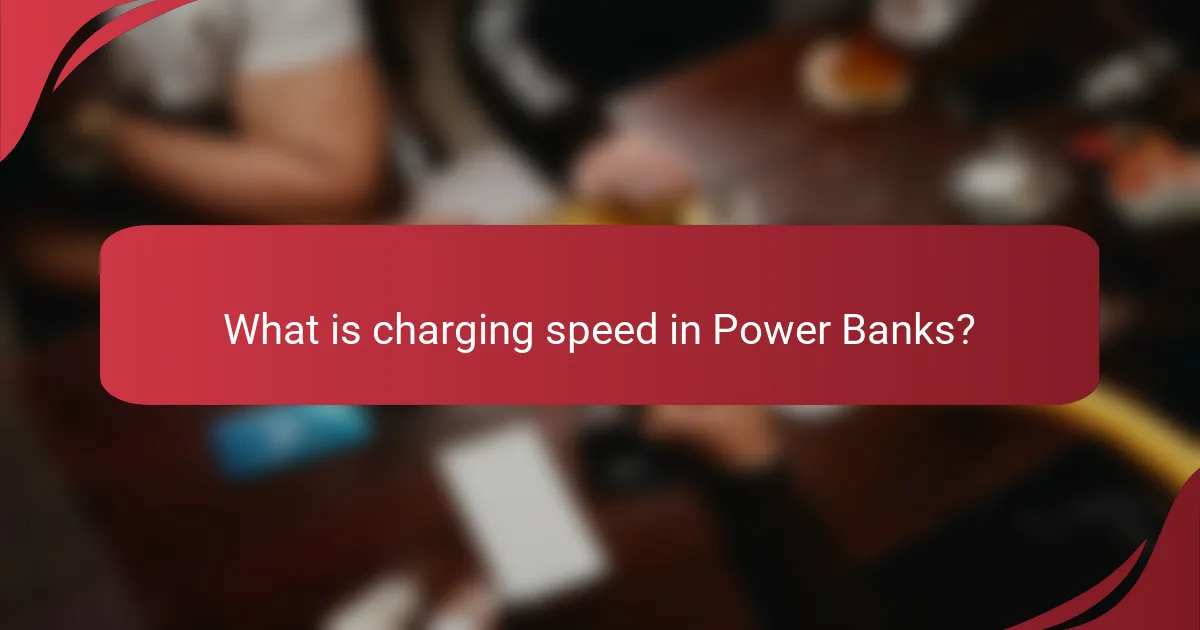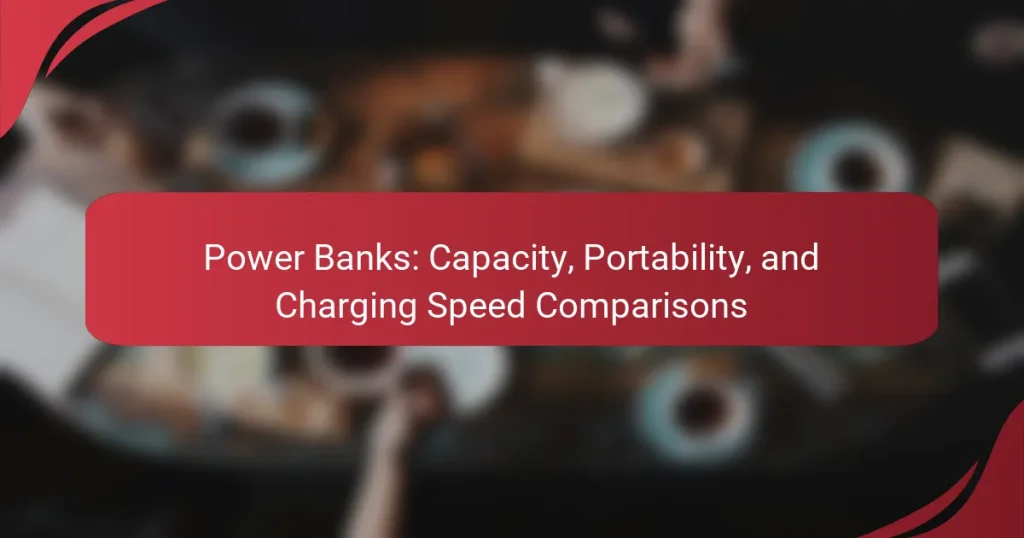Power banks are portable devices designed to charge electronic devices by storing electrical energy in a built-in battery. This article provides a comprehensive overview of power bank capacity, portability, and charging speed, essential factors for users seeking efficient charging solutions. It explains how capacity, measured in milliampere-hours (mAh), influences the number of charges a power bank can provide, and highlights the importance of portability for user convenience. Additionally, the article discusses charging speed, detailing how modern power banks utilize fast charging technologies to enhance efficiency. Understanding these key aspects helps consumers make informed choices when selecting a power bank for travel or emergency situations.

What are Power Banks?
Power banks are portable devices used to charge electronic devices. They store electrical energy in a built-in battery. Users can recharge smartphones, tablets, and other gadgets on the go. Power banks come in various capacities, typically measured in milliampere-hours (mAh). Common capacities range from 2000 mAh to 30000 mAh. They often feature multiple USB ports for simultaneous charging. Many power banks include fast charging technology to enhance charging speed. The convenience of power banks makes them popular for travel and outdoor activities.
How do Power Banks function?
Power banks function by storing electrical energy in rechargeable batteries. They convert and store energy from an external power source, typically through a USB connection. When a device needs charging, the power bank releases the stored energy. Most power banks use lithium-ion or lithium-polymer batteries for efficient energy storage. They contain circuitry that manages the charging and discharging process. This circuitry ensures safe operation by preventing overcharging and overheating. Power banks also feature various output ports to accommodate different devices. The capacity of a power bank is measured in milliampere-hours (mAh), indicating how much energy it can store.
What components make up a Power Bank?
A power bank consists of several key components. The primary component is the battery, which stores electrical energy. Lithium-ion or lithium-polymer batteries are commonly used due to their high energy density. The next component is the charging circuit, which regulates the flow of electricity during charging and discharging. This circuit ensures safe operation and prevents overcharging. Additionally, a power bank includes a control chip that manages the charging process and monitors battery health. Lastly, there are input and output ports, typically USB, for connecting devices and charging the power bank itself. Each of these components plays a crucial role in the functionality of a power bank.
How does battery chemistry influence Power Bank performance?
Battery chemistry significantly influences Power Bank performance. Different chemistries, such as lithium-ion and lithium-polymer, affect energy density, charge cycles, and discharge rates. Lithium-ion batteries typically offer higher energy density, allowing for more capacity in a smaller size. This results in longer usage times for devices. Lithium-polymer batteries, while often bulkier, provide more flexibility in design and can be safer under certain conditions. Charge cycles vary between chemistries; lithium-ion batteries generally support more cycles before degradation. Discharge rates also differ; lithium-ion batteries can deliver higher power output, enhancing charging speed. Therefore, the choice of battery chemistry directly impacts how efficiently a Power Bank operates.
What are the different types of Power Banks?
There are several different types of power banks available in the market. They can be categorized based on their capacity, size, and functionality. Common types include portable power banks, which are lightweight and designed for travel. Solar power banks harness solar energy, making them ideal for outdoor use. Wireless power banks offer the convenience of charging without cables. Fast charging power banks support rapid charging protocols for quicker device charging. Multi-port power banks can charge multiple devices simultaneously. Lastly, rugged power banks are built to withstand extreme conditions and are suitable for outdoor adventures. Each type serves specific user needs and scenarios.
What are the distinctions between portable and stationary Power Banks?
Portable power banks are designed for mobility and convenience. They are compact and lightweight, allowing users to carry them easily. Portable power banks typically have a battery capacity ranging from 2,000 mAh to 30,000 mAh. They can charge devices on-the-go, making them ideal for travel or outdoor activities.
Stationary power banks, on the other hand, are larger and designed for fixed locations. They often have a higher capacity, exceeding 30,000 mAh. Stationary power banks are used to provide power to multiple devices simultaneously. They are commonly found in homes, offices, or public charging stations.
The key distinction lies in their intended use. Portable power banks prioritize mobility, while stationary power banks focus on providing sustained power at a fixed location.
How do solar Power Banks differ from traditional ones?
Solar power banks utilize solar panels to harness sunlight for charging, while traditional power banks rely solely on electrical outlets. This key difference allows solar power banks to recharge in outdoor settings without access to electricity. Traditional power banks typically have a fixed battery capacity, while solar power banks often feature a dual charging method, combining solar and electrical charging. The charging time for solar power banks can be significantly longer, depending on sunlight availability. For instance, a solar power bank may take several hours to fully charge from sunlight, whereas traditional power banks can recharge in a couple of hours from an outlet. Additionally, solar power banks are often designed for outdoor use, making them more rugged and weather-resistant. Traditional power banks are generally lighter and more compact but lack the ability to harness solar energy. Overall, the main distinctions lie in the charging methods, portability options, and intended use cases.

What is Power Bank capacity and why does it matter?
Power bank capacity refers to the amount of electrical energy a power bank can store, measured in milliampere-hours (mAh). This capacity determines how many times a power bank can recharge a device before needing to be recharged itself. A higher capacity means more power storage, allowing for multiple charges of smartphones or tablets. For example, a 10,000 mAh power bank can typically charge a smartphone two to three times, depending on the device’s battery size. Understanding power bank capacity is important for users to select a device that meets their charging needs during travel or emergencies.
How is Power Bank capacity measured?
Power bank capacity is measured in milliampere-hours (mAh). This unit indicates how much electric charge the power bank can store. For example, a power bank with a capacity of 10,000 mAh can theoretically supply 10,000 milliamperes for one hour. However, actual performance can vary due to energy loss during charging and discharging. The efficiency of the power bank also influences its effective capacity. Typically, the usable capacity is lower than the stated capacity due to these factors.
What does mAh mean in relation to Power Banks?
mAh stands for milliampere-hour, a unit that measures electrical capacity. In relation to power banks, mAh indicates how much charge the power bank can store. For example, a power bank with a capacity of 10,000 mAh can theoretically provide 10,000 milliamperes of current for one hour. This measurement helps consumers understand how many times a power bank can recharge a device. Higher mAh values typically mean more charging cycles for smartphones and tablets. Thus, mAh is crucial for assessing the performance and usability of power banks.
How does capacity affect charging multiple devices?
Capacity directly influences the ability to charge multiple devices simultaneously. Higher capacity power banks can store more energy, allowing them to charge several devices without depleting their charge quickly. For example, a 20,000 mAh power bank can often charge multiple smartphones several times. In contrast, a 5,000 mAh power bank may only charge a smartphone once or twice before needing a recharge. Therefore, the capacity of a power bank determines how many devices can be charged and how frequently they can be charged before the power bank itself requires recharging.
Why is capacity important for users?
Capacity is important for users because it determines how much energy a power bank can store. A higher capacity allows for multiple device charges before needing a recharge. For example, a power bank with a capacity of 20,000 mAh can typically charge a smartphone three to five times. This is crucial for users who rely on their devices throughout the day. Additionally, capacity directly impacts the duration of use for devices while away from power sources. Users can select power banks based on their specific charging needs, ensuring they have enough power for their activities. Thus, understanding capacity helps users make informed choices about power banks.
How does high capacity benefit users on the go?
High capacity power banks benefit users on the go by providing extended battery life for devices. Users can charge smartphones, tablets, and other gadgets multiple times without needing to find an outlet. This is especially useful during travel, outdoor activities, or long workdays. High capacity power banks typically range from 20,000 mAh to 50,000 mAh. This capacity allows for several full charges of most smartphones. For instance, a 20,000 mAh power bank can charge an average smartphone about four to five times. Users experience less anxiety over battery life, enabling them to stay connected longer. This convenience supports productivity and entertainment while on the move.
What are the trade-offs of choosing a high-capacity Power Bank?
High-capacity power banks offer extended charging potential but come with trade-offs. They are generally larger and heavier than lower-capacity models. This can affect portability, making them less convenient to carry. Additionally, high-capacity power banks may take longer to recharge fully. Charging speed can also be slower if the power bank is used while charging devices. Furthermore, they often come at a higher price point compared to their lower-capacity counterparts. Users must weigh the benefits of extended usage against the drawbacks of size, weight, and cost.

How does portability impact Power Bank usability?
Portability significantly enhances power bank usability. A portable power bank is lightweight and compact, making it easy to carry. Users can conveniently transport it in pockets or bags. This ease of transport encourages frequent use, especially during travel. Portable power banks allow users to charge devices on the go. According to a survey by Statista, 55% of consumers prioritize portability when selecting a power bank. This preference indicates that usability is closely tied to how easily the device can be carried. Higher portability leads to increased user satisfaction and reliance on the device for charging needs.
What factors contribute to a Power Bank’s portability?
The portability of a power bank is influenced by its size, weight, and design. Smaller dimensions make it easier to carry. A lightweight construction enhances convenience during travel. The shape of the power bank also affects how easily it fits in pockets or bags. Battery capacity plays a role; higher capacity often leads to larger size. Materials used in construction impact weight and durability. Additionally, the presence of a built-in cable can reduce the need for extra accessories. All these factors together determine how practical a power bank is for on-the-go use.
How do size and weight influence portability?
Size and weight significantly influence the portability of power banks. Smaller and lighter power banks are easier to carry and store. They fit conveniently in pockets or bags. Conversely, larger and heavier power banks can be cumbersome. They may require dedicated space in a backpack or purse. Research indicates that the ideal weight for portable devices is under 200 grams. This weight allows for comfortable handling during travel. Additionally, compact dimensions enhance the overall user experience. Users are more likely to carry power banks that are lightweight and compact.
What design features enhance the portability of Power Banks?
Compact size enhances the portability of power banks. Smaller dimensions make them easier to carry in pockets or bags. Lightweight materials contribute to reduced overall weight. Ergonomic shapes improve handling and comfort during transport. Built-in cables eliminate the need for extra accessories. Multi-device compatibility increases functionality without adding bulk. Textured surfaces can enhance grip, preventing slips during use. These features collectively make power banks more user-friendly and convenient for on-the-go charging.
Why is portability crucial for consumers?
Portability is crucial for consumers because it allows for convenient use of devices on the go. Many consumers rely on mobile devices for communication, work, and entertainment. A portable power bank ensures that these devices remain charged during travel. Research shows that 70% of consumers prefer lightweight and compact power banks. Portability enhances user experience by providing flexibility and accessibility. Consumers can easily carry power banks in bags or pockets. This feature is particularly important for frequent travelers and outdoor enthusiasts. Overall, portability directly influences consumer satisfaction and device usability.
How does portability affect everyday usage scenarios?
Portability significantly enhances the practicality of power banks in everyday usage scenarios. Users can easily carry portable power banks in bags or pockets. This convenience allows for charging devices on-the-go. Portability enables users to maintain device functionality during travel, commutes, or outdoor activities. A portable power bank can provide power during emergencies, ensuring devices remain operational. According to a survey by Statista, 67% of consumers prioritize portability when selecting power banks. Thus, portability directly influences user satisfaction and device reliability in various situations.
What are the best practices for selecting a portable Power Bank?
When selecting a portable power bank, consider its capacity, portability, and charging speed. Capacity is measured in milliampere-hours (mAh). A power bank with at least 10,000 mAh can charge most smartphones multiple times. Portability involves size and weight, which should be manageable for daily carry. Look for a power bank that easily fits in your bag or pocket. Charging speed is determined by output voltage and current, usually expressed in volts (V) and amperes (A). A power bank with 2.1A output charges devices faster than one with 1A. Additionally, check for multiple output ports for charging multiple devices simultaneously. Finally, ensure the power bank has safety features like overcharge protection to prevent damage to your devices.

What is charging speed in Power Banks?
Charging speed in power banks refers to the rate at which a power bank can charge devices. This speed is typically measured in watts (W) or amperes (A). Higher charging speeds allow devices to recharge more quickly. Most modern power banks support fast charging technologies such as Quick Charge or Power Delivery. For example, a power bank with a 20W output can charge compatible devices significantly faster than one with a 5W output. Thus, the charging speed is a critical factor for users who prioritize quick device recharges.
How is charging speed measured?
Charging speed is measured in watts (W), which is the product of voltage (V) and current (A). Higher wattage indicates faster charging capabilities. For example, a power bank with a 5V output and 2A current has a charging speed of 10W. This metric helps consumers compare different power banks. Various standards, such as Quick Charge and Power Delivery, influence charging speeds. These technologies optimize voltage and current for efficient charging. Testing equipment, like multimeters, is often used to measure actual charging performance.
What do terms like Fast Charge and Quick Charge mean?
Fast Charge and Quick Charge refer to technologies that allow devices to charge at a significantly faster rate than standard charging methods. Fast Charge typically increases the charging current or voltage, reducing the time needed to fully charge a device. Quick Charge, developed by Qualcomm, uses a specific communication protocol to optimize power delivery, allowing compatible devices to achieve faster charging speeds. For example, Quick Charge can deliver up to 18 watts of power, compared to standard USB charging at 5 watts. These technologies enhance user convenience by minimizing downtime for devices, especially smartphones and tablets.
How do different charging ports affect speed?
Different charging ports affect speed by determining the power output and compatibility with devices. USB Type-C ports typically support higher power delivery, allowing faster charging rates. USB-A ports usually provide lower power output, resulting in slower charging. The specifications of each port dictate the maximum wattage it can deliver. For instance, USB 3.0 can deliver up to 4.5 watts, while USB Power Delivery can exceed 100 watts. Devices also influence charging speed; if a device is designed for fast charging, it will benefit more from compatible ports. Consequently, using the appropriate port can significantly enhance charging efficiency.
Why does charging speed matter to users?
Charging speed matters to users because it directly affects how quickly devices can be powered up. Faster charging reduces downtime for users who rely on their devices throughout the day. For instance, a power bank with a charging speed of 18W can fully charge a smartphone in about 1.5 hours. In contrast, a 5W charger may take over 3 hours for the same device. Users benefit from quick recharges during short breaks or while on the go. Additionally, fast charging technology, such as Qualcomm Quick Charge, enhances user convenience. According to a study by Strategy Analytics, 58% of users prioritize charging speed when selecting portable chargers. Thus, charging speed is a crucial factor for users seeking efficiency and reliability in their power solutions.
How does faster charging impact device usage?
Faster charging significantly enhances device usage by reducing downtime. Users can recharge devices quickly, enabling more frequent use. Studies indicate that devices can reach 50% charge in as little as 30 minutes with fast charging technology. This efficiency allows users to spend less time plugged in and more time using their devices. Additionally, faster charging supports intensive usage scenarios, such as gaming or streaming, where battery drain occurs rapidly. Consequently, users experience improved productivity and convenience. Overall, faster charging directly correlates with increased device accessibility and user satisfaction.
What are the risks associated with high-speed charging?
High-speed charging can pose several risks. One major risk is overheating, which can damage the battery and reduce its lifespan. Additionally, high-speed charging may lead to battery swelling, a condition that can cause physical damage to devices. There is also a risk of reduced battery efficiency over time due to the stress of rapid charging cycles. Furthermore, using incompatible chargers can increase these risks, potentially leading to short circuits or fire hazards. Studies have shown that prolonged exposure to high-speed charging can significantly impact battery health and safety.
What should consumers consider when choosing a Power Bank?
Consumers should consider capacity, portability, charging speed, and safety features when choosing a power bank. Capacity is measured in milliampere-hours (mAh) and indicates how much charge the power bank can hold. A higher capacity means more charges for devices. Portability refers to the size and weight of the power bank. A lightweight and compact design is ideal for travel. Charging speed is determined by the output power, measured in watts. Faster charging speeds can save time when powering up devices. Safety features include overcharge protection and temperature control to prevent damage. These factors ensure the power bank meets user needs effectively.
How do capacity, portability, and charging speed interact?
Capacity, portability, and charging speed interact in a power bank by influencing usability and efficiency. Higher capacity allows more energy storage, enabling multiple device charges. However, increased capacity often results in larger size and weight, impacting portability. Portability refers to how easily a power bank can be carried. A balance between capacity and portability is essential for user convenience. Charging speed is determined by the power output of the bank. Faster charging speeds can deplete the capacity quicker, affecting the number of charges available. Thus, users must consider these attributes together to select an optimal power bank for their needs.
What are the common troubleshooting tips for Power Banks?
Common troubleshooting tips for power banks include checking the charging cable for damage. Ensure the cable is properly connected to both the power bank and the device. Verify that the power bank is charged; many models have indicator lights showing battery status. If the power bank does not charge devices, try a different device to rule out compatibility issues. Resetting the power bank can resolve temporary glitches; refer to the user manual for specific reset instructions. Inspect the power bank for any physical damage that may affect functionality. Avoid exposing the power bank to extreme temperatures, as this can impact performance. Regularly clean the ports to prevent dust buildup, which can hinder charging.
Power banks are portable devices designed to charge electronic gadgets by storing electrical energy in built-in batteries. This article provides a comprehensive overview of power bank capacity, portability, and charging speed, detailing how these attributes affect usability and performance. Key components, types, and the impact of battery chemistry on functionality are discussed, alongside practical considerations for consumers when selecting a power bank. Additionally, the article addresses the importance of charging speed, the implications of high-capacity options, and common troubleshooting tips for optimal use.

